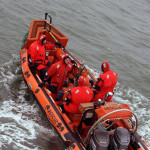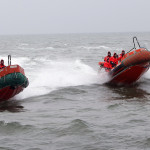Viking Saatsea puts crew training in its place
SMM 2014 sets the scene for a fundamental change in the way shipowners and offshore asset owners train their crews to comply with STCW and OPITO requirements, and the systems they use to track and report on such certifications. And it will also be the launch pad for the first onboard training system that enables them to design and build their own, fully customised courses for any training task .
Leading the change, and present at Viking’s stand in Hall B1 , is Viking Saatsea, the maritime software developer recently acquired by marine safety equipment manufacturer Viking Life-Saving Equipment. Viking Saatsea develops 24/7 onboard training systems for OPITO and STCW crew certification , addressing the need of vessel and rig owners and operators to continuously train their crews by offering a combined solution that manages planning, implementation and documentation.
Unanswered needs
For a company of Viking’s size to acquire a much smaller company in the software business, there must be a significant, unfulfilled and growing customer need to be answered. And Viking Saatsea’s CEO, Kim Baarsøe, is keen to talk about the problems his company’s products have been purpose – built to solve.
“Vessel and rig owners desperately need to improve their training capabilities,” he says. “To start with, training has to speed up. Due to scheduling delays and the need to conduct most training at land-based facilities, the time from identification of a crew certification requirement to the certificate actually being available when it’s time to sail can be up to three months. That’s far too long – and a real problem for any sector that needs to mobilise crew quickly to meet business opportunities.”
“Often, personnel are urgently required at sea but, even if they have recently completed required training, they can’t report for work until they have been appropriately certified or re-certified. And that becomes very costly for the business .”
Kim Baarsøe also points to other limitations of existing training solutions, most of which are land-based. For example, Viking Saatsea’s market research has shown that the current costs of training a crew member are widely considered to be too high. At the same time, certificate administration – finding out which crew members are available with the right certification for the job, who needs their skills upgraded or refreshed, and the current status of training activities by vessel or individual – is far too resource-heavy.
“Managing training is a complex and time-consuming task with an ever – present risk of error,” he explains. “As a consequence, vessel and rig owners risk delays, exposures to liability and financial losses.”
Reality – based solution
“The time is ripe for onboard, computer-based learning to be applied to these problems,” says Kim Baarsøe. “But one difficulty has been that software developers haven’t got the same combination of education and maritime backgrounds as Viking Saatsea does . So they haven’t designed systems that take a vessel or rig-owner’s realities into account.”
Limited bandwidth
The realities he is talking about include, for example, the fact that bandwidth at sea is often extremely limited–down to as little as 1 kbit/sec , which is far less than an ordinary fax machine requires. Yet current alternatives to Viking Saatsea’s solution require constant internet connection in order to provide training – or the courses need to be run from fixed media such as DVDs.
Viking Saatsea’s solution, however, is impervious to the connection status, enabling it to run either online or offline – and to be accessed both at sea and from land – based locations for administration purposes. Moreover, its here-and-now training flexibility receives greater acceptance from crew being trained, because they are able to undergo training while at sea rather than in their own, off – the – job time. It’s also easier to track training status at individual or vessel levels, and in contrast to typical land – based courses, crew being trained on board can use the appropriate types and brands of equipment.
Build – your – own courses
That’s all good news for vessel and rig owners. But what’s really making them sit up and listen, according to Kim Baarsøe , is the fact that Viking Saatsea’s software can also allow customers to create their own , task-specific courses using exactly the same interface and full functionality of the company’s core offerings. With Viking Saatsea’s help, such courses can achieve the same, high-quality ‘rich media’ content of the software developer’s own offerings.
New refresher packages
SMM 2014 will also see Viking Saatsea release new refresher packages designed to help shipowners and offshore operators comply with the tougher demands of STCW 2010, which comes into full force on 1 January 2017. With 15 months to go, every available seat in land-based training facilities will soon be booked . The new refresher packages let vessel and rig-owners keep basic education on board up-to-date by combining theoretical with practical exercises and reducing land-based training to a single day every 5 years.
Meet the team
Viking Saatsea’s onboard training experts will be on hand at Viking’s stand (Hall B1, booth EG.504 ) to demonstrate th e new solution and to answer questions from press and prospective customers about how onboard training can reduce training costs and save valuable time compared with training at land – based facilities. They will also be hand ing out a Best Practice Guide des igned to help vessel and rig-owners choose the right type of solution for their specific needs.









